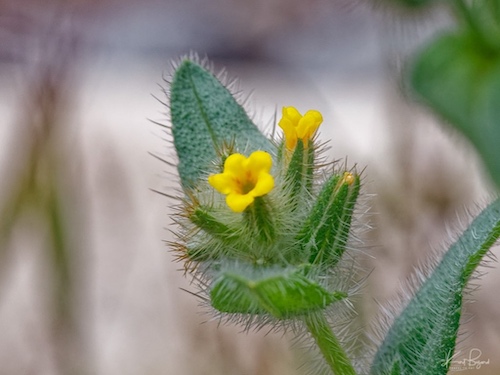
Desert plants tend to look very different from plants native to other regions. They are often swollen, spiny, and have tiny leaves that are rarely bright green. A desert always has a limitation of water but the temperature may be hot or cold, high altitude and cloudy like parts of Costa Rica or low altitude and windy like the Cape Preserve in South Africa. The strange appearance of these plants is a result of their remarkable adaptations to the challenges of the desert climate. Desert plants have developed three main adaptive strategies with diverse implementations often in different species with convergent evolution to the same form: succulence, drought tolerance and drought avoidance in annual plants. Each of these is a different but effective suite of adaptations for prospering under conditions that would kill plants from other regions. These differences often extend to the cellular level with the development of special structures to store water in leaves and stems, the periodic shedding of leaves, and special adaptations to even the basic photosynthesis process. Chlorophyll (the green pigment in plants) is the only known substance in the universe that can capture volatile light energy and convert it into a stable form usable for biological processes (chemical energy) through the Calvin Cycle and the enzyme RuBisCO. Green plants use blue and red light energy to combine low-energy molecules (carbon dioxide and water) into high-energy molecules (carbohydrates or starch), which they accumulate and store as energy reserves. There are at least three variations of photosynthesis, all of which use the same basic mechanism, C3 carbon fixation used by most plants, C4 carbon fixation used in about 3% of plants and the CAM (crassulacean acid metabolism) carbon fixation pathway that evolved in plants like cactus as an adaptation to arid conditions.
Chloroplasts
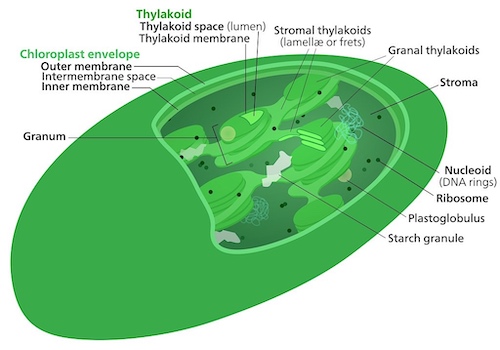
Chloroplasts are similar to mitochondria, the energy centers of cells, in that they have their own genome, or collection of genes, contained within circular DNA. These genes encode proteins essential to the organelle and to photosynthesis. Like mitochondria, chloroplasts are also thought to have originated from primitive bacterial cells through the process of endosymbiosis. New chloroplasts may contain up to 100 copies of their DNA, though the number of chloroplast DNA copies decreases to about 15–20 as the chloroplasts age. They are usually packed into nucleoids, which can contain several identical chloroplast DNA rings. Many nucleoids can be found in each chloroplast and multiple chloroplasts can be found in each photosynthetic cell. Chloroplasts are highly dynamic—they circulate and are moved around within plant cells, and occasionally pinch in two to reproduce. Their behavior is strongly influenced by environmental factors like light color and intensity. In most plants (C3 carbon fixation) the photosynthesis, carbon fixation and Calvin cycle all occur in a single chloroplast.
Stomata
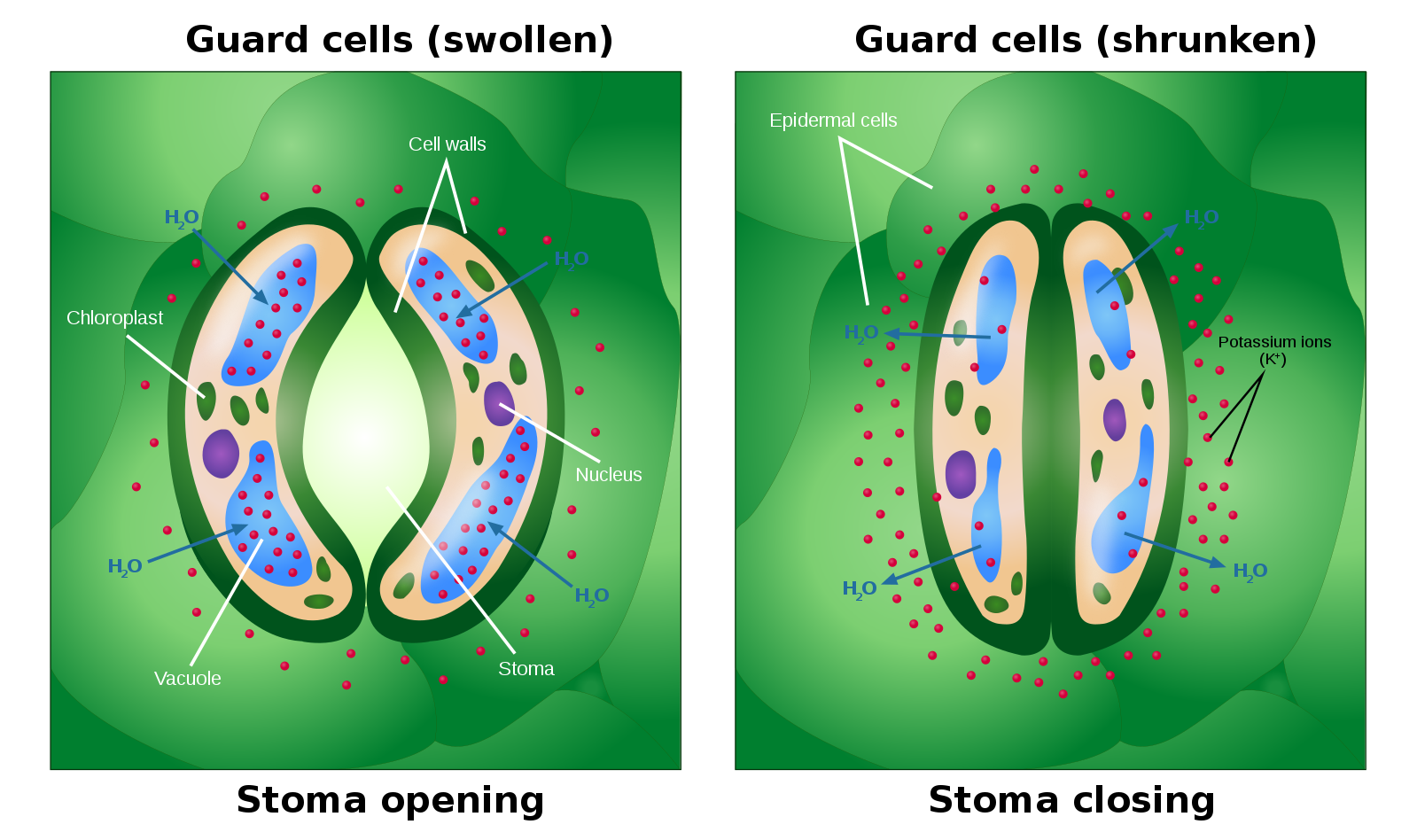
Consider the leaf to be a factory, various resources need to enter and leave, much like the loading docks in a factory. Water and the essential minerals (such as nitrogen, phosphorus, potassium, magnesium, calcium, sulfur and magnesium) come with the water up the roots to the leaves. CO2 is absorbed and oxygen is expelled through pores in the bottom of the leaf or stem. Guard cells surround each stoma. They help to regulate the rate of transpiration by opening and closing the stomata. Light is a major stimulus involved in stomatal conductance, and has two key elements that are involved in the process: the stomatal response to blue light, and photosynthesis in the chloroplast of the guard cell. The stomata open when there is an increase in light, and they close when there is a decrease in light. Each guard cell has a relatively thick cuticle on the pore-side and a thin one opposite it. As water enters the cell, the thin side bulges outward like a balloon and draws the thick side along with it, forming a crescent; the combined crescents form the opening of the pore. Studies have explored the relationship between drought stress and stomatal conductance. Through these experiments, researchers have found that a drought resistant plant regulates its transpiration rate via stomatal resistance/conductance. This minimizes water loss and allows the plant to survive under low water conditions.
Calvin Cycle

Photosynthesis occurs in two stages in a cell. In the first stage, light-dependent reactions capture the energy of light and use it to make the energy-storage and transport molecules ATP and NADPH. The Calvin cycle uses the energy from short-lived electronically excited carriers to convert carbon dioxide and water into organic compounds that can be used by the organism (and by animals that feed on it). This set of reactions is also called carbon fixation. The key enzyme of the Calvin cycle is called RuBisCO. The process was first identified by American biochemist Dr. Melvin Calvin in 1957. In this post, I will concentrate on Mohave Desert C3 plants.
Creosote Bush (C3)
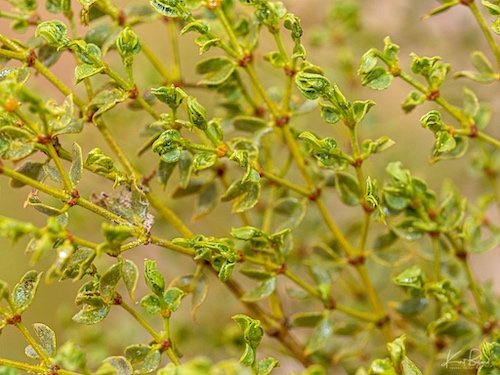
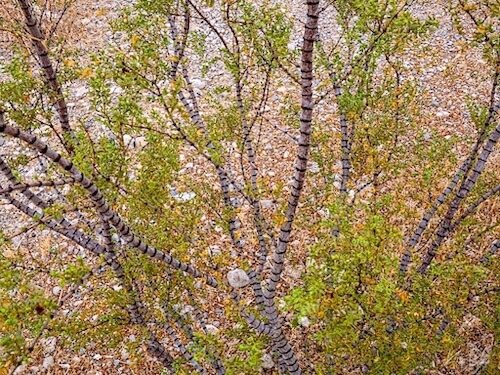
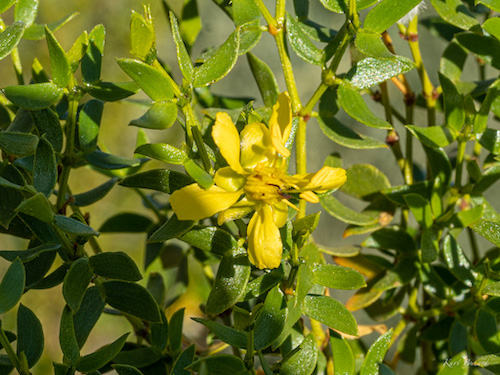
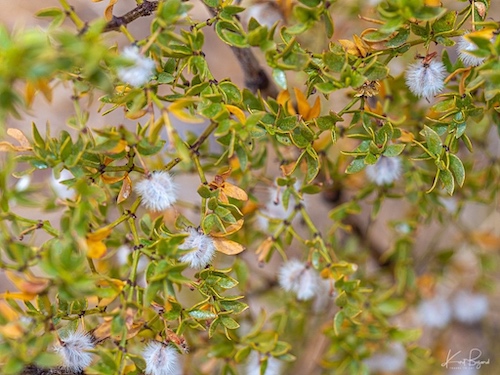
On many creosote bushes you will see black areas on some branches. This is a microbial community of algae, fungi, and bacteria that in exchange for a place to live, gives the plant nutrients as rainwater flows over it and into the soil. It is from a combination of this and dust that has settled on its branches between storms that allows creosote bush to pick up 9 times as much phosphorus and 16 times as much nitrogen than is in regular rainwater. These nutrients are rare in the desert and give the plant a huge leg up over its competition.
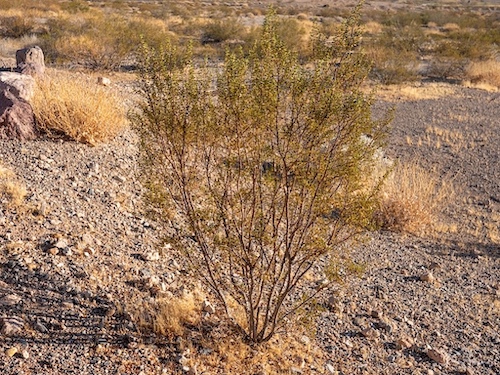
A cone shape allows creosote bush to channel rain down its stems so that the water goes deeper into the soil and the roots have more time to absorb it. It can also grow into a hemisphere, an upside down bowl shape that allows leaf litter and other organic material to collect beneath its branches. This creates an island of fertility that allows other plants and animals to live underneath, creating a rich soil that is full of nutrients for the creosote bush.
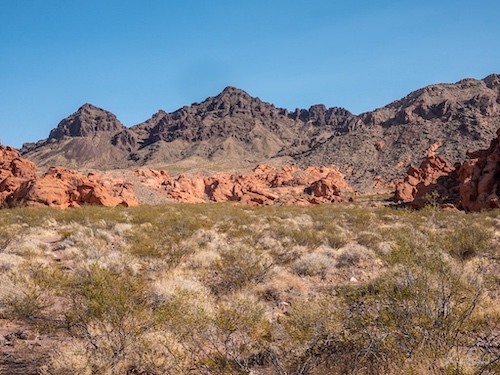
Creosote bush is the most drought-tolerant perennial plant of North America and the most common plant in Lake Mead National Recreational Area. It can live for at least 2 years with no water at all, by shedding its leaves and even shedding branches, it is drought deciduous. But usually it is an evergreen plant, retaining its thick, green, resin-coated leaves or allowing them to dry down and turn golden-brown in periods of seasonal drought. In this condition the leaves can still synthesise some sugars – enough to keep the plants alive. The extreme drought-tolerance of the leaves is due to several factors: the leaves are small with a low surface area for water loss, the leaf cuticle is very thick and waxy, and the high stomatal resistance. Coupled with all this, the tissues of the leaves can have very high water potentials, caused by high levels of chemicals, so they can withstand drought conditions. The stems of the plant bear resinous, dark green leaves with two opposite lanceolate leaflets joined at the base, with a deciduous “awn” between them.
White Bursage (C3)
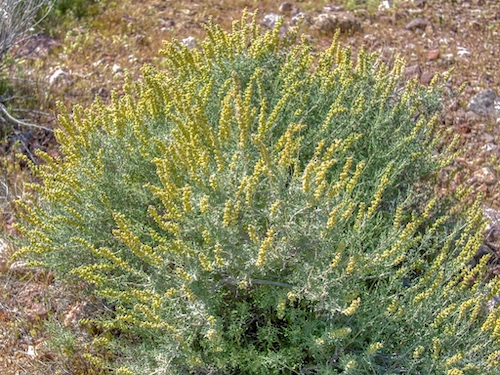
Ambrosia dumosa, the burro-weed or white bursage, is a North American species of plants in the sunflower family. It is a common constituent of the creosote-bush scrub community throughout the Mojave desert of California, Nevada, and Utah and the Sonoran Desert of Arizona and northwestern Mexico. Ambrosia dumosa has been studied to determine allelopathic interactions with creosote bush, Larrea tridentata, which produces a chemical that inhibits the growth of A. dumosa. Other studies have suggested that A. dumosa roots produce a chemical that causes them to grow away from conspecific roots, preventing competition for water resources. In addition to burrow-weed, A. dumosa is also commonly called bur sage, burro weed, and burro bush. Ambrosia dumosa becomes dormant during drought, losing all of its leaves to prevent water loss by transpiration; drought deciduous. During this time it can still be recognized by the presence of longitudinal stripes on smaller stems.
Catclaw Acacia (C3)
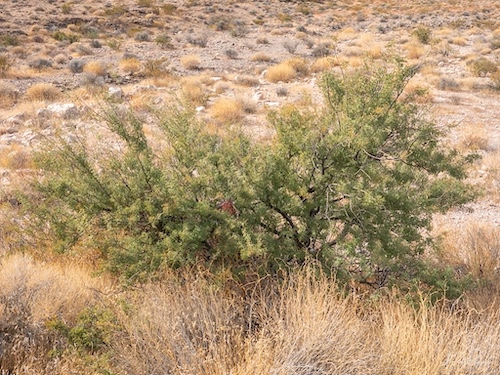
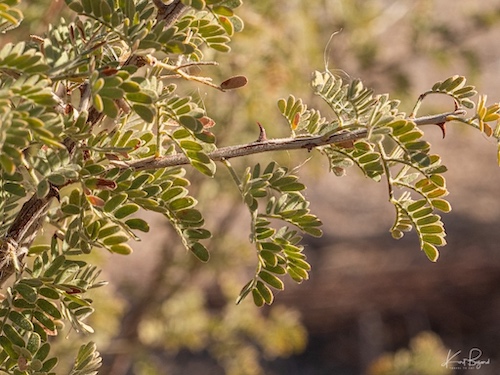
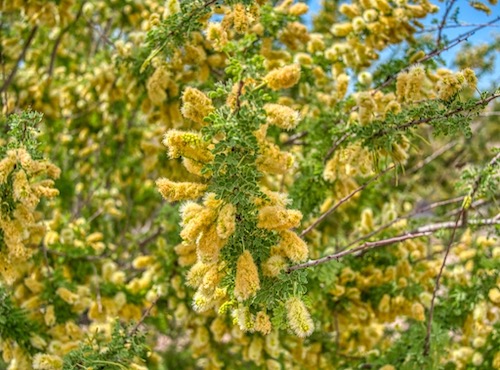
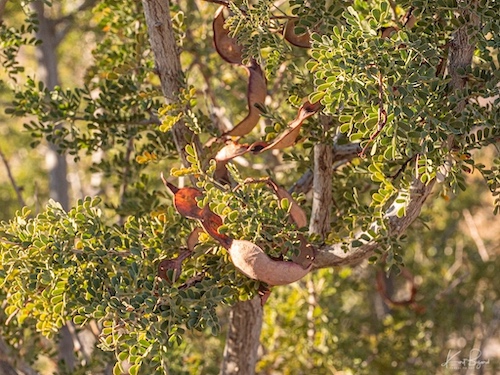
Senegalia greggii, formerly known as Acacia greggii, is a species of Senegalia in the legume family native to the southwestern United States and northern Mexico, from the extreme south of Utah south through southern Nevada, southeast California, Arizona, New Mexico and western Texas to Baja California, Sinaloa and Nuevo León in Mexico. Common names include catclaw acacia, catclaw mesquite, Gregg’s catclaw, paradise flower, wait-a-minute bush, and wait-a-bit tree; these names mostly come from the fact that the tree has numerous hooked prickles with the shape and size of a cat’s claw, that tend to hook onto passers-by; the hooked person must stop (“wait a minute”) to remove the prickles carefully to avoid injury or shredded clothing. Senegalia greggii is most common in arroyos where its roots have access to deep water. Its seeds require physical scarification in order to germinate. This effectively prevents germination unless a flash flood disturbs the area and deposits enough water to increase the likelihood that seedlings will be able to establish deep enough roots to survive the dry season. Catclaw is fully drought deciduous (drops its leaves during drought) and will usually lack leaves for most of the year. Unlike other legumes, S. greggii is not known to form root nodule associations with nitrogen-fixing bacteria.
Joshua Trees (C3)
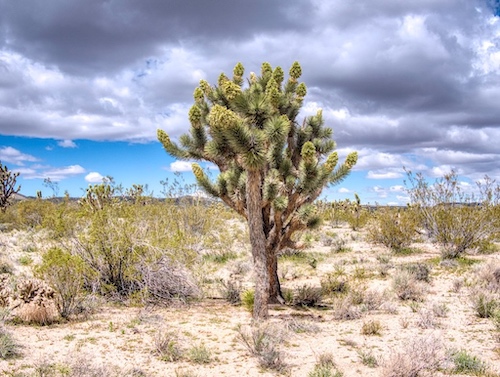
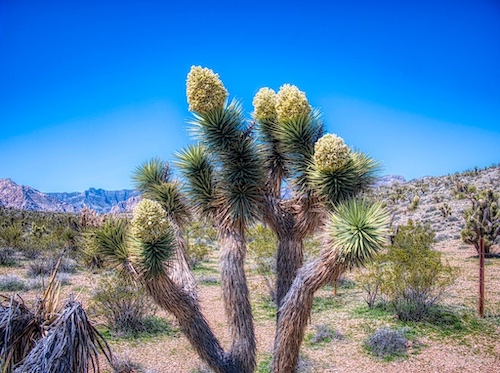
The Mormons named the Joshua tree after the biblical figure, Joshua. The trees appeared to them as if they were raising their branches in supplication. Other travelers, such as John Fremont, described Joshua trees as “repulsive.” Both revered and disdained, these members of the yucca genus have become a symbol of the desert and provide habitat for animals that range from the Scott’s Oriole to the Northern flicker. They grow in elevations that range from 3,000–7,000 feet with an average life span of 150 years. As protection from predation, Joshua Trees often germinate under nurse plants until the age of four years. Once their spiny limbs develop, they eventually overtake the nurse plant. Like all yucca, Joshua Trees rely on the Pronuba moth (Tegeticula yuccasella) to pollinate its creamy cluster of white flowers. Joshua trees acquire their energy by C3 photosynthesis although other Yucca use C4 carbon fixation.
Brittlebush (C3)
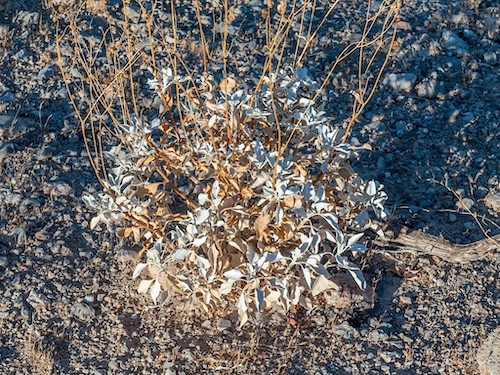
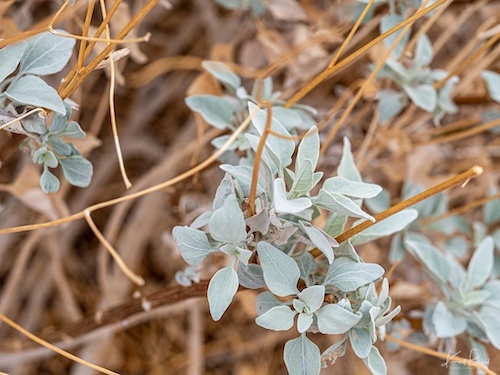
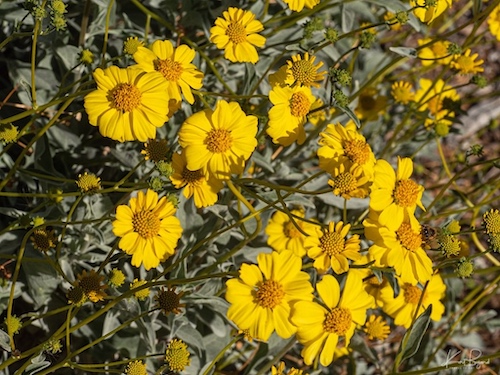
Brittlebush (Encelia farinosa) is a medium-size shrub with oval, silver-gray leaves covered in tiny, fuzzy hairs. In the late winter and early spring, this Aster family plant produces beautiful yellow flowers on stems extending above the shrub. Brittlebush is found throughout the Sonoran Desert and in the warmer areas of the Mojave Desert. The name is derived from its fragile and breakable stems. The O’odham and Seri natives used brittlebush to haft sharp points on arrows and fishing spears. The Seri also collected plant resin from the upper section of this shrub to be used as a sealant for their pottery containers. The resin is viscous and transparent yellow. The hairs on the brittlebush plant serve several purposes. Many desert plants have hairy leaves or stems. The hairs act like a blanket over the leaves to protect them from the heat and cold. The white color reflects the sunlight helping to keep the plant cool. They also help trap any moisture and reduce the amount of water lost.
Desert Marigold (C3)
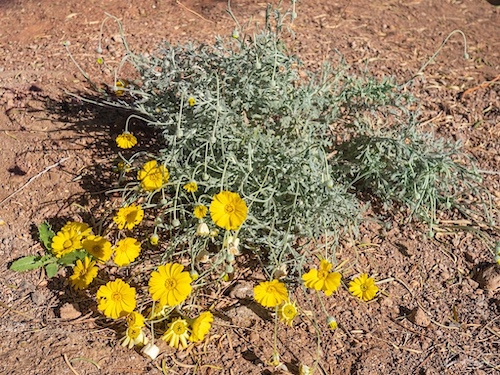
Desert marigold, a member of the Asteraceae family, grows twelve inches tall and wide with fuzzy greenish-gray leaves and a compact, mounded shape. While a short-lived plant, it beautifies the landscape by producing bright yellow, daisy-like blossoms that grow on long stems. The plant blooms through the early spring and into the summer months, and may intermittently bloom all year, except during the cold weather. Desert Marigolds are one of the most conspicuous spring wildflowers across the arid lands of the southwest. They begin to flower in March and will continue to bloom off and on until November. Rain triggers additional rounds of flowering. They commonly grow on stony slopes and sandy plains and mesas and are most abundant on roadsides, where they may form dense yellow carpets. They range in elevation from 100 to 6500 feet. Their drought tolerance and long flowering season have made the desert marigold a popular plant in the horticultural world. The term “Baileya” honors Jacob Whitman Bailey (1811–1857). Although several members of Asteraceae are C4 plants, from what I can find, Baileya multiradiata uses C3 photosynthesis.
Parralena (C3)
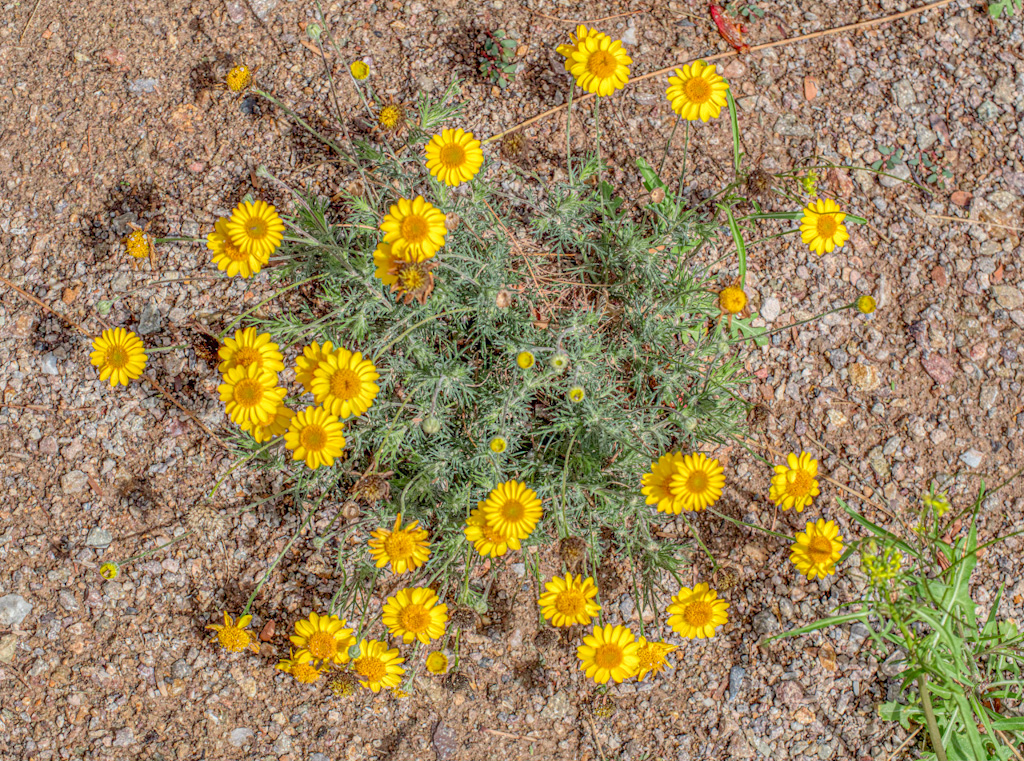
Thymophylla pentachaeta, also known as fiveneedle pricklyleaf, golden dyssodia, dogweed, or Parralena is a perennial or subshrub in the family Asteraceae. The species is native to the southwestern United States (Mohave Desert) and Mexico. This common low plant frequently grows near Creosote Bush (Larrea tridentata) and Snakeweed (Gutierrezia sarothrae) or among piñon, juniper, and Snakeweed. The closely related Prickly Fetid Marigold (T. acerosa) is more woody and prickly, with flower heads that sit among undivided leaves. Both species were once included in the larger genus Dyssodia. Thymophylla is one of dozens of western North American genera that also have species in southern South America but have no species in the great distance between these two regions. This range distribution probably requires the long-distance dispersal of seeds, perhaps by migratory birds.
Desert Dandelion (C3)
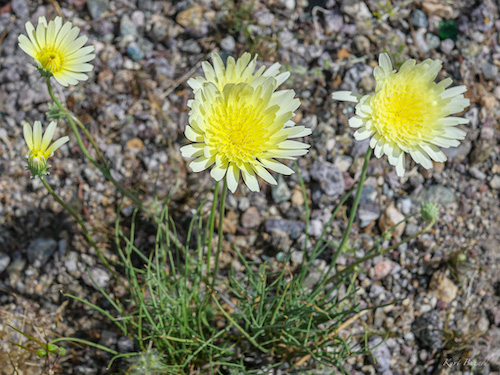
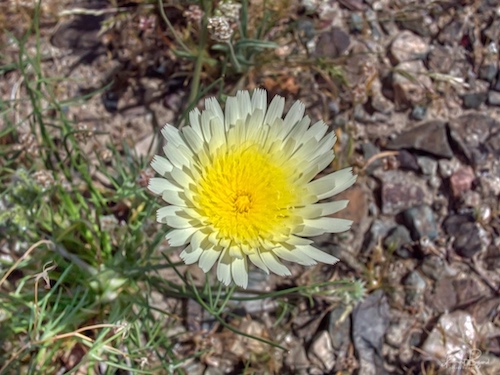
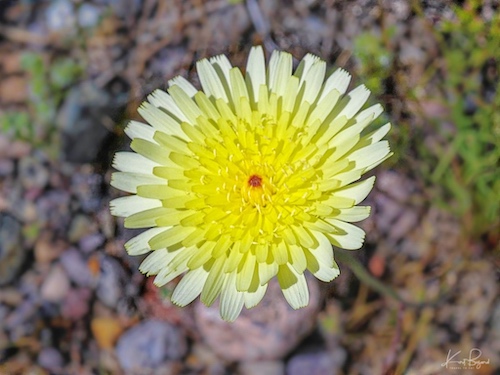
Malacothrix glabrata (smooth desert dandelion or desert dandelion) is an spring annual plant in the sunflower family (Asteraceae). It is common to the southwestern deserts of North America and has showy pale-yellow to white flowers. The name “glabrata” refers to the leaves being (nearly) hairless. Like other members of its genus, it has a milky sap and flower heads composed of smaller strap-like flowers called “ligules”. The species is native to the western United States, excluding much of the Pacific Northwest, and into northern Mexico. It is common and abundant following winters with heavy rainfall on plains and mesas; coarse soils, rocky hillsides, open areas or among shrubs in desert habitats, often in creosote (Larrea) sandy washes and flats, bush communities, foothill woodlands. Malacothrix glabrata is the desert’s version of the common dandelion growing in the Mojave, Great Basin, and Sonoran deserts. It has milky sap and the color is actually a pale yellow while the vegetative parts are mostly smooth or (glabrous).
Sacred Datura (C3)
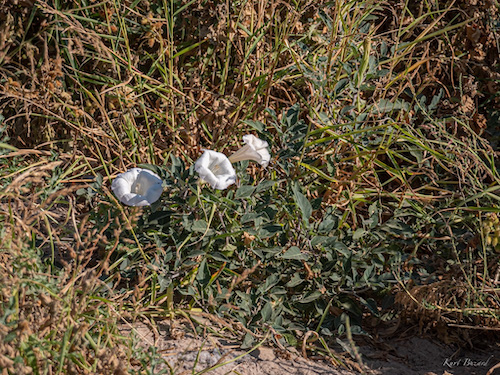
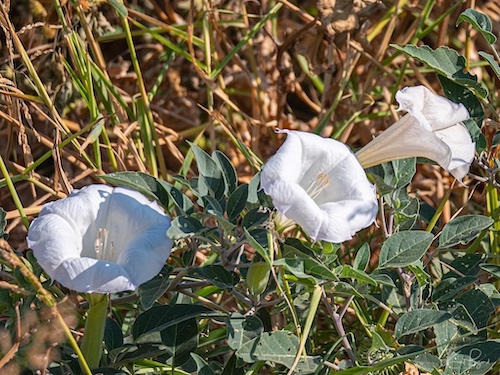
Datura wrightii, commonly known as sacred datura, is a poisonous perennial plant species and ornamental flower of the family Solanaceae native to the Southwestern United States and northwestern Mexico. It is sometimes used as a hallucinogen due to its psychoactive alkaloids. Common names in the US include “sacred thorn-apple” or “hairy thornapple”, and sometimes “western Jimson weed” because of its resemblance to Datura stramonium. Anglophone settlers in California often called it “Indian whiskey” because of its ritual intoxicating use by many tribes; the name “sacred datura” has the same origin. This is a C3 photosynthetic plant which blooms from April through October. In clear weather, flowers open in the morning and evening and close during the heat of the day (depending on water availability); in cloudy weather, they may open earlier and last longer. Traditionally, Datura has been used for mystic and religious purposes, as a natural drug to treat asthma, pain, gout, boils, abscesses, and wounds, and as psychoactive infusions and fumitories. Different Datura species exhibit diverse ethnopharmacological activities against different diseases, and many ancient and traditional cultures have used various forms of Datura to treat ailments and to prevent many diseases.
Coyote Mellon (C3)
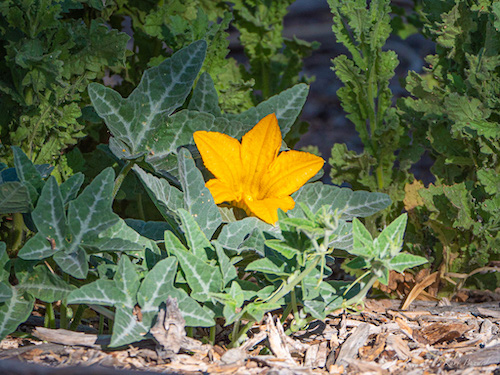
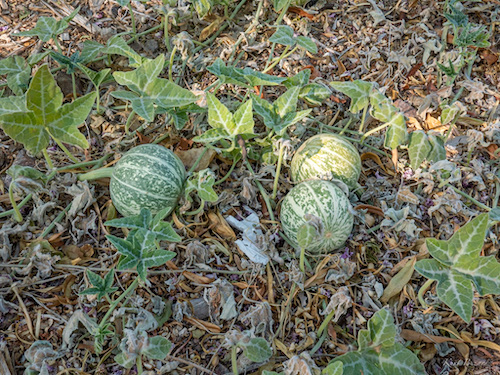
Cucurbita palmata is a species of flowering plant in the squash family known by the common names coyote melon and coyote gourd. It is similar to Cucurbita californica, Cucurbita cordata, Cucurbita cylindrata, and Cucurbita digitata and all these species hybridize readily. Each member of this species group is native to the Southwestern United States and Northwestern Mexico where they are relatively uncommon. Each group member is found in hot, arid regions with low rainfall. They prefer soil that is loose, gravelly, and well-drained. The cup-shaped flowers of cucurbita palmata are unusually large, up to 3 inches long, opening to four, five or six lobes, which tend to have irregular edges and a few lengthwise grooves. Like all cucurbitaceae species, plants are vines; they grow sideways, the stems along the ground, with large leaves at closely-spaced intervals. Leaves are palmate in outline, but sharply divided (about half way to the central vein) into 4 to 6 lobes, each with a few smaller lobes, or teeth, along the edge. Leaves and flowers have a covering of short, dense hairs. One flower is produced from each leaf node, and it may contain either stamens or pistils. Nodes also produce a branched tendril. The fruit is a spherical melon, up to 4 inches in diameter, initially dark green with lighter stripes, becoming all yellow as it ripens. Despite its appearance, the fruit is not edible by humans. The striped, green gourds are fibrous and unpalatable inside, but ground seeds were eaten by native Indians, and the dried gourds were used as rattles in dances. This is a relatively uncommon species, restricted to arid regions in and around the Mojave Desert.
Spiny Herb (C3)
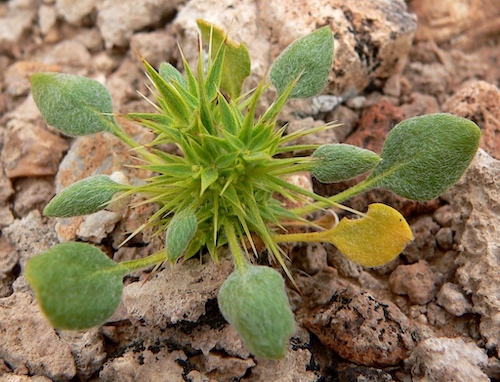
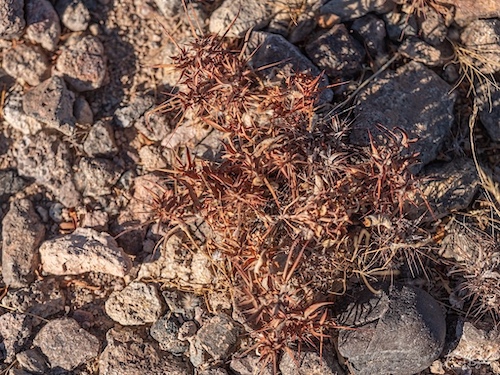
Chorizanthe rigida, with the common names of devil’s spineflower, rigid spineflower, spiny-herb, rigid spiny-herb, is an annual plant in the family Polygonaceae the buckwheats. It is a member of the genus Chorizanthe, the spineflowers and is found in the southwestern United States and northwest Mexico. It grows quickly, especially following spring rains. With the onset of early summer it turns into a spine-skeleton. It has a main taproot, mostly longer than the plant is tall, taking advantage of the rainfall’s ground moisture. It is conspicuous when growing in its bright new green state; when desiccated its spiny skeleton is blackish, dark gray, or of medium browns and blends in easily to the desert background ground colors. Desert annuals spend most of their life as seeds (i.e. from a year to even several years), germinating and growing when moisture is available. Chorizanthe rigida is a winter desert annual germinating during the cool season and setting seed at the end of the spring. It’s tiny flowers produce an achene that matures inside an involucre composed of three spiny bracts. Chorizanthe rigida has an interesting dispersal mechanism: the involucres are attached to the plant by a stem that when wet, softens, allowing raindrops to detach them. Bracts that appear in a whorl subtending an inflorescence are collectively called an involucre. This adaptation ensures the seeds are released at the exact right time, when there was rain, to achieve optimal fertility.
Desert Peppergrass (C3)
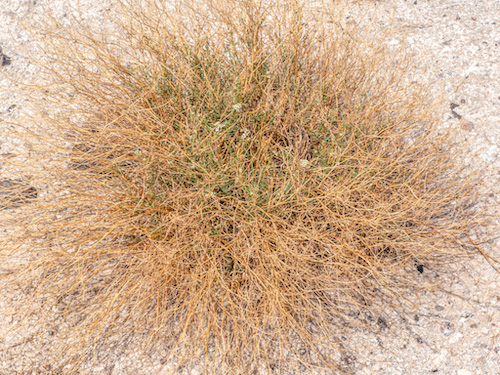
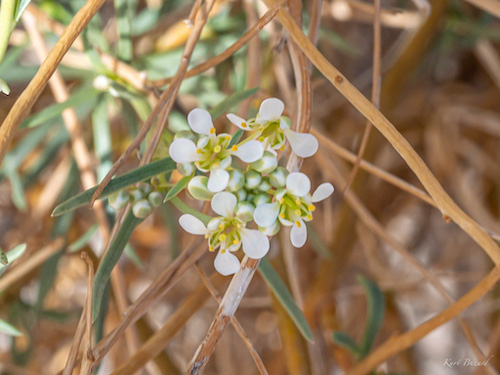
Lepidium fremontii, the desert pepperweed, is a species of flowering plant in the mustard family which is native to the southwestern United States, where it grows on sandy desert flats and the rocky slopes of nearby hills and mountains. It takes its scientific name from John C. Frémont. The range extends from the Mojave Desert northwards across most of Nevada, up to 6,500 feet elevation. Individual white-petaled, yellow-centered flowers of lepidium fremontii are tiny, about 1/4 inch in diameter, but they form dense, spherical or elongated clusters, on a shrub-like plant which is unremarkable for much of the year when not in bloom but quite distinctive in spring and early summer. Flowers are formed of four obovate, yellowish-green sepals and four larger, white, clawed, spatula-shaped petals, non-overlapping. All plant parts are hairless. Stems and leaves are greyish-green in color; leaves grow all along the stem, though not at the base. Plants branch profusely, generally staying quite close to the ground but reaching heights of 3 feet in favorable locations.
Nye Milkvetch (C3)
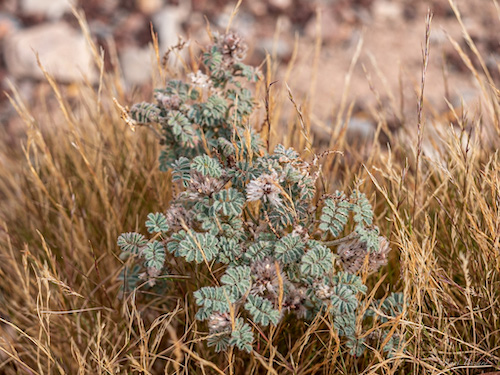
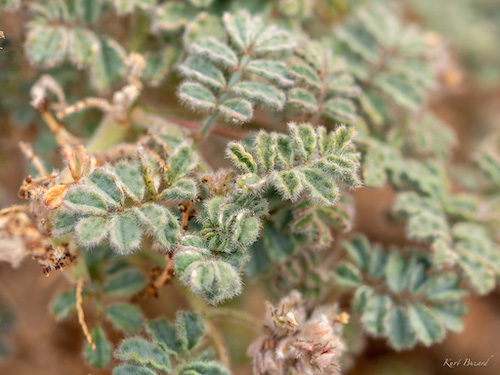
Astragalus (Fabaceae), the largest genus of plants in the world with an estimated 3270 species, is known for large numbers of rare endemic species. Most taxa in the genus have relatively small ranges of distribution, with 50% restricted geographically to a single Jepson Bioregion. The California Native Plant Society lists 51 Astragalus taxa (35% of the native Astragalus taxa) as rare, threatened, or endangered (RTE). Climate characteristics of geographic regions such as rainfall and temperature extremes show no obvious relationship to species richness or the proportion of listed taxa. Species richness is highest in the arid Great Basin (35 species and 53 taxa) combining both its components, followed by 29 species and 39 taxa in the Sierra Nevada East region that includes the White and Inyo Mountains. The Mojave Desert is also high in diversity with 32 species and 39 taxa, but in contrast the Sonoran Desert region is low with only 12 species and 14 taxa. Nye Milkvetch (Astragalus nyensis) is a prostrate, hairy annual forb with pinnately divided leaves. It occurs only in Clark, Lincoln, and Nye counties in Nevada. It blooms in the spring with small, pea-like flowers, white with pale purple veins and highlights.
Desert Rock Nettle (C3)
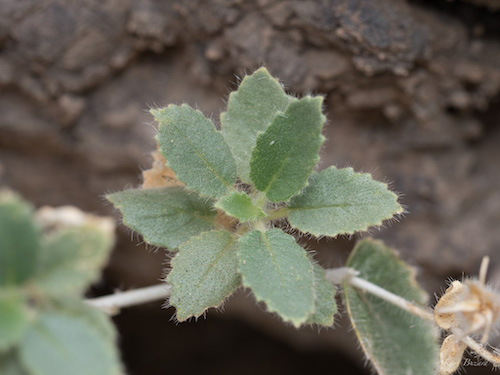
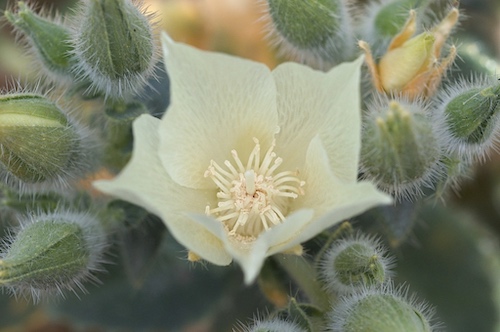
Eucnide urens, also known as desert rock nettle or desert stingbush, is a shrub which is native to desert areas in Nevada, California, Arizona, Utah and Baja California. Other common names are velcro plant and vegetable velcro. The flowers, which appear from spring to early summer, are cream or pale yellow with 5 petals and are 1-2 inches long. The coarsely serrated leaves are 1-2.5 inches (2-6.5 cm) long with stinging hairs which are also found on the stems and buds. The plant is round and bushy and is usually between 30 and 60 cm in height and is often found on cliff faces. Desert bighorn sheep feed on the flowers.
Bristly Fiddleneck (C3)
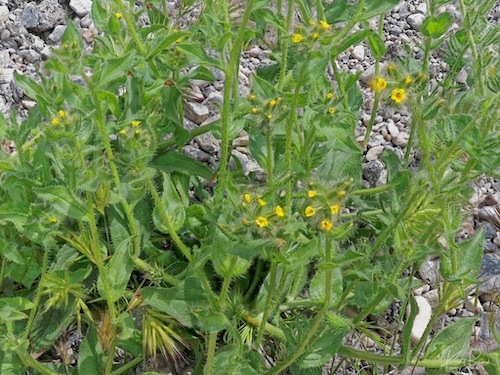
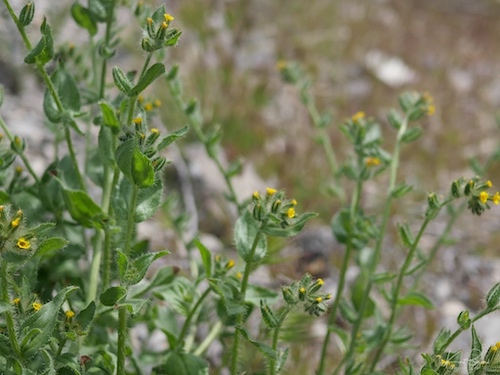

Amsinckia tessellata is a species of fiddleneck known by the common names bristly fiddleneck, tessellate fiddleneck, checker fiddleneck, and devil’s lettuce. It is a common plant in many types of habitats, including chaparral, oak woodland, xeric scrub, temperate valleys, disturbed areas, and deserts including the Mojave Desert and Sonoran Desert. This is a bristly annual herb similar in appearance to other fiddlenecks. Its coiled flower cluster holds yellow to orange tubular flowers up to a centimeter wide at the corolla, which often has fewer than five lobes. Two varieties are var gloriosa, with a corolla about half an inch long and anthers separate from the stigma, and var tessellata, where the corolla is less than half an inch long and the anthers are touching the stigma. The seeds and foliage of fiddlenecks are poisonous to livestock, particularly cattle, because they contain alkaloids and high concentrations of nitrates. The sharp hairs of the plants can cause skin irritation in humans. However, the shoots, seeds or leaves of several species were used as food by Native Americans, and the plant also had some medicinal uses.
Globemallow (C3)
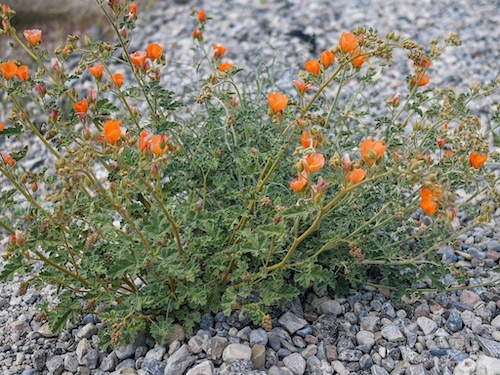
Sphaeralcea ambigua, commonly known as Desert Globemallow or Apricot Mallow, is a member of the genus Sphaeralcea in the mallow family (Malvaceae). It is a perennial shrub native to parts of California, Nevada, Utah, and Arizona in the U.S.; and Sonora and Baja California in Northwest Mexico. It grows well in alkaline soil, both sandy or clay, usually in the company of creosote bush scrub and desert chaparral habitats. The Sphaeralcea ambigua plant grows to 3 feet in height, and spreads to 2-4 feet in width. The leaves are fuzzy with white hairs on both sides (star-shaped grayish hairs that reflect sunlight and break up the wind), lobed, veined, and on long stems, the number of which increase with age. The fruit is a brown capsule containing numerous seeds, first quite spherical as implied by the genus name, later flattening to a disk. The flowers are bowl-shaped, 5-petaled, apricot to dark orange red in color, and bloom in the spring. Three varieties; Sphaeralcea ambigua var. ambigua, Sphaeralcea ambigua var. rosacea (flower more lavender) and Sphaeralcea ambigua var. rugosa.
Notch-Leaved Phalacia (C3)
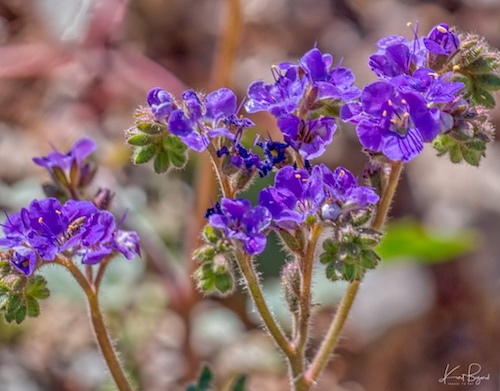
Phacelia crenulata is a species of flowering plant in the borage family, Boraginaceae. Its common names include notch-leaf scorpion-weed, notch-leaved phacelia, cleftleaf wildheliotrope, and heliotrope phacelia. It is native to the southwestern United States as far east as Colorado and New Mexico, and Baja California and Sonora in Mexico. This species is an aromatic annual plant growing up to 80 centimeters tall. It is coated in stiff, glandular hairs. The leaves are 2 to 12 centimeters long, the largest occurring around the base of the stem and those higher on the stem much smaller. They are generally oblong in shape with wavy or lobed edges. The inflorescence is a coiled cyme of several flowers. The flower has a bell-shaped purple or blue corolla up to a centimeter long. The corolla has a white tube and sometimes a white throat. The stamens and style are well exserted from mouth of the flower. The fruit is a somewhat rounded capsule a few millimeters wide. There are 2 to 5 varieties of the species, Phalacia crenulata var. minutiflora is found in California, Nevada, Arizona, Baja California with white-throated lavender to blue flowers up to 4 millimeters long.
Yerba Mansa (C3)
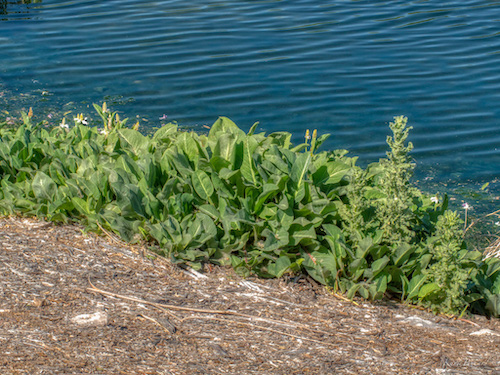
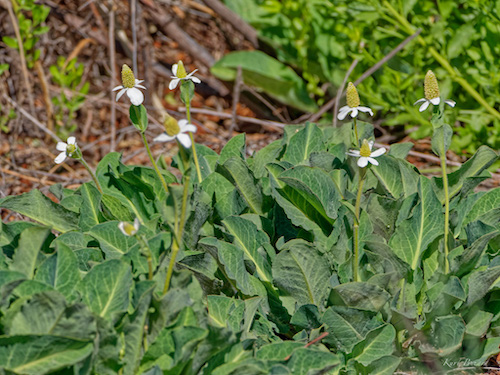
Yerba mansa (Anemopsis californica), is known as the gentle herb in Spanish and is renowned for its many medicinal uses. Native Americans used the aromatic roots and leaves in a variety of teas, infusions, and poultices to treat colds, stomach ache, malaria, dysentery, diabetes, and sore throats. Modern research has corroborated the anti-inflammatory properties of chemicals in the plant‘s roots. Yerba mansa is found primarily on moist, saline soils associated with seeps, streambanks, and springs. Yerba mansa can be recognized by its elongated, cone-like inflorescence of numerous flowers, each with a small, white bract. The whole inflorescence itself is surrounded by a whorl of white petal-like bracts that are often spotted or suffused with red. Superficially, the flower cluster resembles that of the Wind-flower (Anemone), which accounts for its scientific name Anemopsis or Anemone-like. Anemopsis californica is the only native species in the lizard-tail family (Saururaceae) in the Southwest although Saururus cernuus is found in the eastern US. Taxonomists consider the Saururaceae to be one of the more primitive and ancient of the families of flowering plants.
Mohave Suncup (C3)
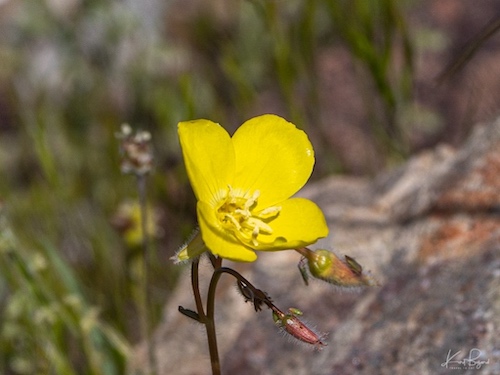
Chylismia brevipes is a species of wildflower native to the American desert southwest known by the common names yellow cups, Mojave suncup, and golden suncup. This is a hairy annual with tall stems often reaching over 1.5 feet (0.5 m) in height and surrounded by basal leaves which may be simple or composed of several leaflets. It produces an inflorescence which has one to several blooms in it. The flowers are bright yellow, often with reddish speckling at the base of each petal. The center of the flower has a long pistil and several shorter stamens with large anthers. The fruits are hanging capsules which may be several centimeters long.
Prince’s Plume (C3)
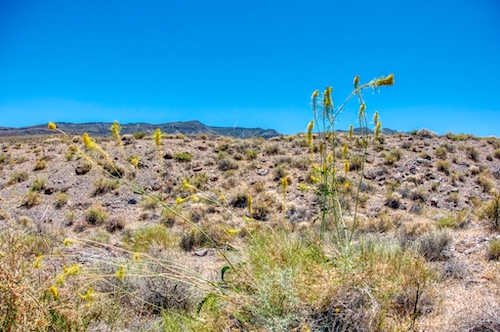
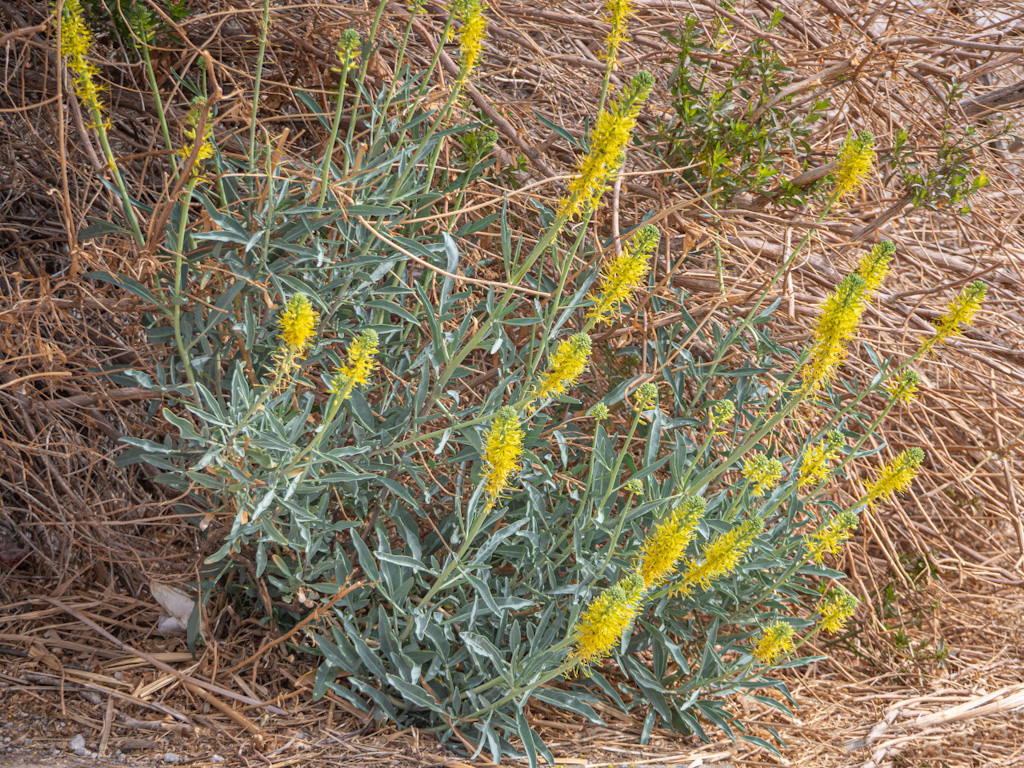
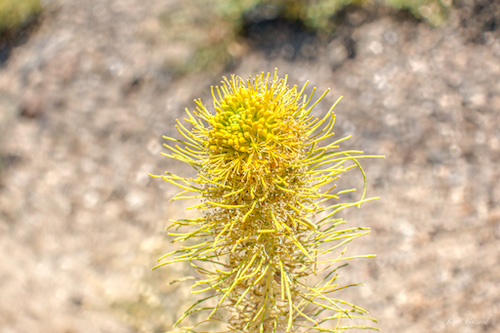
Stanleya pinnata is a species of flowering plant in the mustard family Brassicaceae known as Desert Princes’ Plume, Golden Princes’ Plume, Golden Desert Plume, Sentinel Of The Plains. The plant is native to the western Great Plains and western North America. It occurs in many types of open habitat, including deserts, chaparral, foothills, rocky cliffs, sagebrush, and prairie. It prefers alkali- and gypsum-rich soils. Prince’s plume is a graceful, desert perennial. Its leaves are mostly basal on low, branched, sub-woody crowns. The towering flowering stalks are 5–6 ft. tall and bear racemes of bright-yellow flowers. The flowers are reminiscent of cleomes or spider flowers. Stem leaves are lance-shaped and pinnately divided. Slender wands of yellow flowers top tall, stout, smooth, bluish-green, leafy stems. Stanleya pinnata thrives on selenium rich soils and as a result, crushed stems or leaves may have an unpleasant odor. Environmental concerns about selenium are common in the western USA, and Stanleya pinnata is a potentially useful species for phytoremediation due to its broad adaptation to western soils and environments, and its uptake, metabolism and volatilization of selenium.
Wolfberry (C3)
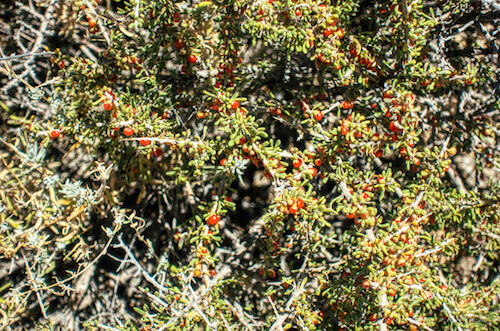
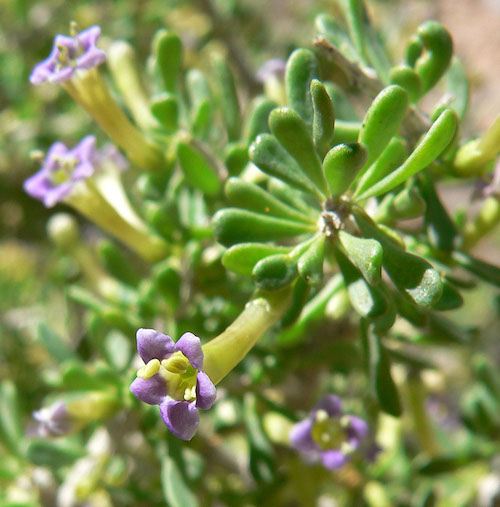
Lycium andersonii is a species of flowering plant in the nightshade family, Solanaceae. Its common names include water-jacket, redberry desert-thorn, Anderson thornbush, Anderson’s desert thorn, Anderson boxthorn, Anderson lycium, Anderson wolfberry, and squawberry. The species is native to the Southwestern United States and northwestern Mexico. This plant grows in sandy, gravelly washes and on slopes and mesas. It tolerates some soil salinity and alkaline soils such as caliche. It thrives in hot, dry climates. It is rarely dominant in the local flora. This deciduous shrub has stiff, arching branches lined with tiny dark green leathery leaves, and tipped with sharp spines. Clusters of small tubular lavender flowers are produced in the spring, followed by juicy red berries.
Castor Bean Plant (C3)
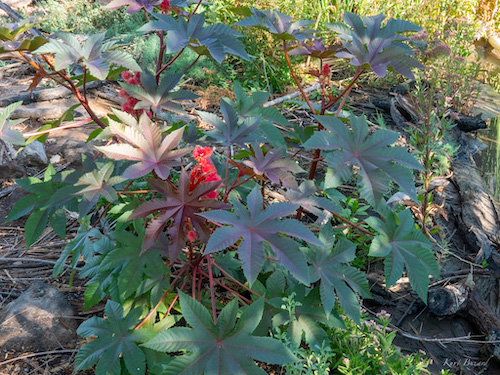
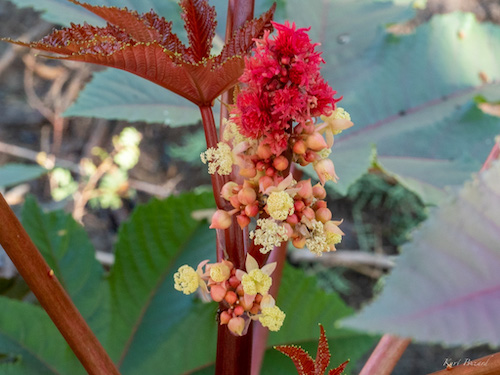
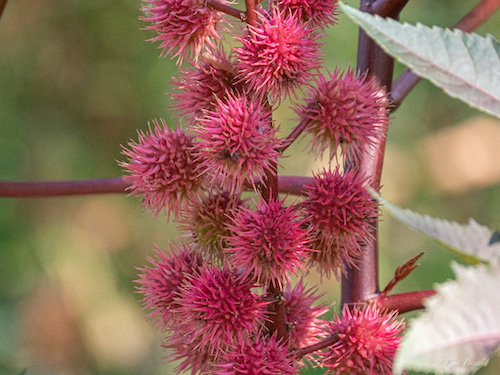
I decided to add these pictures of the Castor Bean plant, not because it is native to the Mohave desert, but because there was a nice specimen in Wetlands park in Las Vegas. Ricinus communis, the castor bean or castor oil plant, is a species of perennial flowering plant in the spurge family, Euphorbiaceae. It is the sole species in the monotypic genus, Ricinus, and subtribe, Ricininae. Its seed is the castor bean, which, despite its name, is not a bean (that is, the seed of many Fabaceae). Castor is indigenous to the southeastern Mediterranean Basin, Eastern Africa, and India, but is widespread throughout tropical regions. Castor Beans have long been grown as annual ornamental plants. The flowers lack petals and are unisexual (male and female) where both types are borne on the same plant (monoecious) in terminal panicle-like inflorescences of green or, in some varieties, shades of red. The male flowers are numerous, yellowish-green with prominent creamy stamens; the female flowers, borne at the tips of the spikes, lie within the immature spiny capsules, are relatively few in number and have prominent red stigmas. The plants grow to towering heights in the late summer garden with spectacular dark green/burgundy 7-pointed leaves and clusters of bright coral-red seed pods. From a distance the seed pod clusters appear to be exotic red flowers. But on closer inspection, they are the plant’s spikey seed heads. Castor seed is the source of castor oil, which has a wide variety of uses. The seed also contains ricin, a water-soluble toxin, which is also present in lower concentrations throughout the plant.
As always, I hope you enjoyed the post and will return for more.
References:
60 Common and Conspicuous plants of the Lake Meade National Recreation Area
Wildflowers of Death Valley National Park
North American Desert Shrubland
Rarity in Austraglus a California Perspective
Spring Yucca Flowers at Red Rock Canyon in Nevada
Photosynthetic Organs of Desert Plants
Annual Plants: Adaptations to Desert Environments
Carbon Reduction Pathways and Standing Crop in Three Chihuahuan Desert Plant Communities
